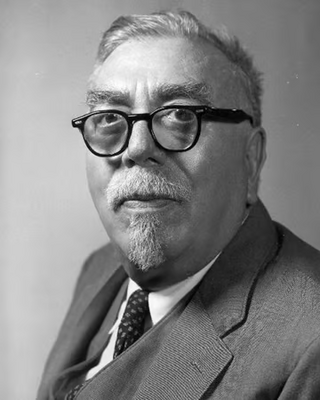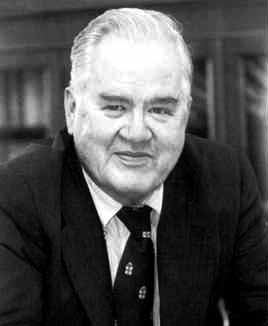The bit is the most basic unit of information in computing and digital communication. The name is a portmanteau of binary digit. The bit represents a logical state with one of two possible values. These values are most commonly represented as either "1" or "0", but other representations such as true/false, yes/no, on/off, or +/− are also widely used.

Claude Elwood Shannon was an American mathematician, electrical engineer, computer scientist and cryptographer known as the "father of information theory" and as the "father of the Information Age". Shannon was the first to describe the Boolean gates that are essential to all digital electronic circuits, and was one of the founding fathers of artificial intelligence. He is credited alongside George Boole for laying the foundations of the Information Age.

John von Neumann was a Hungarian and American mathematician, physicist, computer scientist and engineer. He had perhaps the widest coverage of any mathematician of his time, integrating pure and applied sciences and making major contributions to many fields, including mathematics, physics, economics, computing, and statistics. He was a pioneer in building the mathematical framework of quantum physics, in the development of functional analysis, and in game theory, introducing or codifying concepts including cellular automata, the universal constructor and the digital computer. His analysis of the structure of self-replication preceded the discovery of the structure of DNA.

Quantum information is the information of the state of a quantum system. It is the basic entity of study in quantum information theory, and can be manipulated using quantum information processing techniques. Quantum information refers to both the technical definition in terms of Von Neumann entropy and the general computational term.

Vinton Gray Cerf is an American Internet pioneer and is recognized as one of "the fathers of the Internet", sharing this title with TCP/IP co-developer Bob Kahn.

Norbert Wiener was an American computer scientist, mathematician and philosopher. He became a professor of mathematics at the Massachusetts Institute of Technology (MIT). A child prodigy, Wiener later became an early researcher in stochastic and mathematical noise processes, contributing work relevant to electronic engineering, electronic communication, and control systems.

Bob Kahn is an American electrical engineer who, along with Vint Cerf, first proposed the Transmission Control Protocol (TCP) and the Internet Protocol (IP), the fundamental communication protocols at the heart of the Internet.

John Wilder Tukey was an American mathematician and statistician, best known for the development of the fast Fourier Transform (FFT) algorithm and box plot. The Tukey range test, the Tukey lambda distribution, the Tukey test of additivity, and the Teichmüller–Tukey lemma all bear his name. He is also credited with coining the term bit and the first published use of the word software.

Erector Set was a brand of metal toy construction sets which were originally patented by Alfred Carlton Gilbert and first sold by his company, the Mysto Manufacturing Company of New Haven, Connecticut, in 1913. In 1916, the company was reorganized as the A. C. Gilbert Company. The brand continued its independent existence under various corporate ownerships until 2000, when Meccano bought the Erector brand and consolidated its worldwide marketing with its own brand. The coverage here focuses on the historical legacy of the classic Erector Set; for current developments under the "Erector by Meccano" brand name, see the Meccano article.

Elwyn Ralph Berlekamp was a professor of mathematics and computer science at the University of California, Berkeley. Berlekamp was widely known for his work in computer science, coding theory and combinatorial game theory.

"A Mathematical Theory of Communication" is an article by mathematician Claude E. Shannon published in Bell System Technical Journal in 1948. It was renamed The Mathematical Theory of Communication in the 1949 book of the same name, a small but significant title change after realizing the generality of this work. It has tens of thousands of citations which is rare for a scientific article and gave rise to the field of information theory. Scientific American referred to the paper as the "Magna Carta of the Information Age", while the electrical engineer Robert G. Gallager called the paper a "blueprint for the digital era". Historian James Gleick rated the paper as the most important development of 1948, placing the transistor second in the same time period, with Gleick emphasizing that the paper by Shannon was "even more profound and more fundamental" than the transistor.
Edward Oakley Thorp is an American mathematics professor, author, hedge fund manager, and blackjack researcher. He pioneered the modern applications of probability theory, including the harnessing of very small correlations for reliable financial gain.
Irving Stoy Reed was an American mathematician and engineer. He is best known for co-inventing a class of algebraic error-correcting and error-detecting codes known as Reed–Solomon codes in collaboration with Gustave Solomon. He also co-invented the Reed–Muller code.

The history of computer science began long before the modern discipline of computer science, usually appearing in forms like mathematics or physics. Developments in previous centuries alluded to the discipline that we now know as computer science. This progression, from mechanical inventions and mathematical theories towards modern computer concepts and machines, led to the development of a major academic field, massive technological advancement across the Western world, and the basis of a massive worldwide trade and culture.
A timeline of events related to information theory, quantum information theory and statistical physics, data compression, error correcting codes and related subjects.
The British Society for the History of Mathematics (BSHM) was founded in 1971 to promote research into the history of mathematics at all levels and to further the use of the history of mathematics in education.
Switching circuit theory is the mathematical study of the properties of networks of idealized switches. Such networks may be strictly combinational logic, in which their output state is only a function of the present state of their inputs; or may also contain sequential elements, where the present state depends on the present state and past states; in that sense, sequential circuits are said to include "memory" of past states. An important class of sequential circuits are state machines. Switching circuit theory is applicable to the design of telephone systems, computers, and similar systems. Switching circuit theory provided the mathematical foundations and tools for digital system design in almost all areas of modern technology.
Jimmy Soni is an American author and former managing editor of The Huffington Post. He is best known for A Mind at Play, his biography of Claude Shannon and The Founders: The Story of Paypal and the Entrepreneurs Who Shaped Silicon Valley.
Four Horsemen of the Apocalypse is the name given by gambling authors to the four U.S. Army engineers who first discovered in the 1950s the best playing strategy in the casino game of Blackjack that can be formulated on the basis of the player's and the dealer's cards. The so-called Basic Strategy, which was subsequently refined through the use of computers and combinatorial analysis, loses the least money to the casino in the long term.

Betty Shannon was a mathematician and the main research collaborator of Claude Shannon. Betty inspired and assisted Claude in building some of his most famous inventions.












